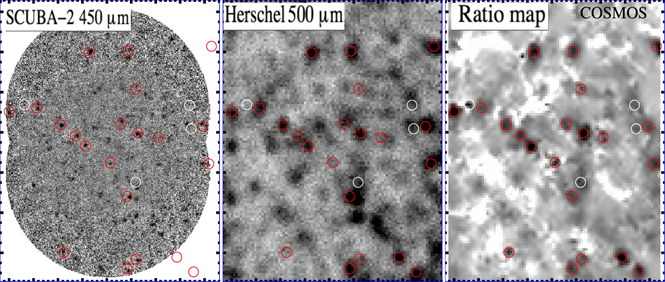We present a new method to search for candidate z ![]() 2 Herschel 500 μm sources in the Great Observatories Origins Deep Survey-North field using a S500 μm/S24 μm “color deconfusion” technique. Potential high-z sources are selected against low-redshift ones from their large 500 to 24 μm flux density ratios. By effectively reducing the contribution from low-redshift populations to the observed 500 μm emission, we are able to identify counterparts to high-z 500 μm sources whose 24 μm fluxes are relatively faint. The recovery of known z
2 Herschel 500 μm sources in the Great Observatories Origins Deep Survey-North field using a S500 μm/S24 μm “color deconfusion” technique. Potential high-z sources are selected against low-redshift ones from their large 500 to 24 μm flux density ratios. By effectively reducing the contribution from low-redshift populations to the observed 500 μm emission, we are able to identify counterparts to high-z 500 μm sources whose 24 μm fluxes are relatively faint. The recovery of known z ![]() 4 starbursts confirms the efficiency of this approach in selecting high-z Herschel sources. The resulting sample consists of 34 dusty star-forming galaxies at z
4 starbursts confirms the efficiency of this approach in selecting high-z Herschel sources. The resulting sample consists of 34 dusty star-forming galaxies at z ![]() 2. The inferred infrared luminosities are in the range 1.5 × 1012–1.8 × 1013 L⊙, corresponding to dust-obscured star formation rates (SFRs) of ~260–3100 M⊙ yr−1 for a Salpeter initial mass function. Comparison with previous SCUBA
2. The inferred infrared luminosities are in the range 1.5 × 1012–1.8 × 1013 L⊙, corresponding to dust-obscured star formation rates (SFRs) of ~260–3100 M⊙ yr−1 for a Salpeter initial mass function. Comparison with previous SCUBA  -selected galaxy samples shows that our method is more efficient at selecting high-z dusty galaxies, with a median redshift of
-selected galaxy samples shows that our method is more efficient at selecting high-z dusty galaxies, with a median redshift of  and with 10 of the sources at z
and with 10 of the sources at z ![]() 4.
4.

SCUBA-2 450 μm image (left), Herschel 500 μm image (middle), and the Herschel 500 μm to Spitzer 24 μm ratio map (right). The data are taken from observations of the COSMOS field. Sources that are detected in the ratio map are shown in red circles with a radius of 15”, while white shows those without counterparts in the 450 μm map. Note that while many bright 500 μm sources disappear in the ratio map, there are few faint sources being more unambiguously revealed in the ratio map. The SCUBA-2 450 μm data are taken from the SCUBA-2 Cosmology Legacy Survey (Geach et al. 2013).
We find that at a fixed luminosity, the dust temperature is ~5 K cooler than that expected from the  relation at
relation at  1, though different temperature selection effects should be taken into account. The radio-detected subsample (excluding three strong active galactic nucleus) follows the far-infrared (far-IR)/radio correlation at lower redshifts, and no evolution with redshift is observed out to
1, though different temperature selection effects should be taken into account. The radio-detected subsample (excluding three strong active galactic nucleus) follows the far-infrared (far-IR)/radio correlation at lower redshifts, and no evolution with redshift is observed out to  , suggesting that the far-IR emission is star formation dominated. The contribution of the high-z Herschel 500 μm sources to the cosmic SFR density is comparable to that of (sub)millimeter galaxy populations at
, suggesting that the far-IR emission is star formation dominated. The contribution of the high-z Herschel 500 μm sources to the cosmic SFR density is comparable to that of (sub)millimeter galaxy populations at  and at least 40% of the extinction-corrected UV samples at
and at least 40% of the extinction-corrected UV samples at  . Further investigation into the nature of these high-z dusty galaxies will be crucial for our understanding of the star formation histories and the buildup of stellar mass at the earliest cosmic epochs.
. Further investigation into the nature of these high-z dusty galaxies will be crucial for our understanding of the star formation histories and the buildup of stellar mass at the earliest cosmic epochs.
Further details can be found in Shu, X. et al. 2016, ApJS, 222, 4
